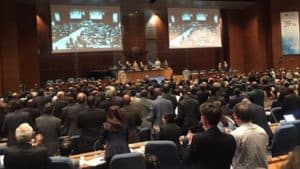As forecasted air traffic experiences continues to grow by 5 per cent annually, international aviation fuel consumption is estimated to grow 2.8 to 3.9 times over the levels seen in 2010, by 2040.
ICAO’s 39th General Assembly has taken steps to achieve the global aspirational goal of carbon-neutral growth from 2020 onwards by recommending to adopt the final Resolution text for the new global market-based measure (GMBM) to control CO2 emissions.
 The Assembly Resolution points to the global MBM scheme in the form of the Carbon Offsetting and Reduction Scheme for International Aviation (CORSIA) to address any annual increase in total CO2 emissions from international civil aviation (i.e. civil aviation flights that depart in one country and arrive in a different country) above the 2020 levels, taking into account special circumstances and respective capabilities.
The Assembly Resolution points to the global MBM scheme in the form of the Carbon Offsetting and Reduction Scheme for International Aviation (CORSIA) to address any annual increase in total CO2 emissions from international civil aviation (i.e. civil aviation flights that depart in one country and arrive in a different country) above the 2020 levels, taking into account special circumstances and respective capabilities.
The average level of CO2 emissions from international aviation covered by the scheme between 2019 and 2020 represents the basis for carbon-neutral growth from 2020, against which emissions in future years are compared. In any year from 2021 when international aviation CO2 emissions covered by the scheme exceed the average baseline emissions of 2019 and 2020, this difference represents the sector’s offsetting requirements for that year.
CORSIA will be implemented in phases, starting with the participation of States on a voluntary basis, followed by the participation of all States except the exempted States, as follows:
- Pilot phase (from 2021 through 2023) and first phase (from 2024 through 2026) would apply to States that have volunteered to participate in the scheme; and
- Second phase (from 2027 through 2035) would apply to all States that have an individual share of international aviation activities in RTKs in year 2018 above 0.5 per cent of total RTKs or whose cumulative share in the list of States from the highest to the lowest amount of RTKs reaches 90 per cent of total RTKs, except Least Developed Countries (LDCs), Small Island Developing States (SIDS) and Landlocked Developing Countries (LLDCs) unless they volunteer to participate in this phase.
States that voluntarily decide to participate the CORSIA may join the scheme from the beginning of a given year and should notify ICAO of their decision to join by June 30 the preceding year.
The coverage of the scheme on the basis of routes between States must also be defined: a route will be covered by the scheme if both States connecting the route are participating in the scheme; similarly, a route will not be covered by the scheme if one or both of States connecting the route are not participating in the scheme.

Once participation of States and routes covered by the CORSIA are defined in a given year from 2021, and offsetting requirements in the given year (i.e. increased emissions beyond the average baseline emissions of 2019 and 2020) are set, the requirements are distributed among aircraft operators participating in the scheme, as per the formula in the Assembly Resolution.
The Assembly Resolution includes a concept of “a dynamic approach” for the distribution of offsetting requirements, which moves gradually from the use of 100 per cent sectoral rate (and 0 per cent individual) from 2021 to 2029, towards the use of individual rates of at least 20 per cent from 2030 to 2032; and at least 70 per cent from 2033 to 2035. The “sectoral rate” represents the international aviation sector’s global average growth factor of emissions in a given year, while the “individual rate” represents an individual operator’s growth factor of emissions in a given year.
It is important to note that, regardless of the phased implementation or exemptions under the CORSIA, all States with aircraft operators undertaking international flights are requested to compile and transmit aggregated emissions information of their operators to ICAO, as part of the activities included in the States’ implementation of a monitoring, reporting and verification (MRV) system.
CORSIA calls for international aviation to address and offset its emissions through the reduction of emissions elsewhere (outside of the international aviation sector), involving the concept of “emissions units”. One emissions unit thereby represents one tonne of CO2. Two main types of emissions units exist: “offset credits” from crediting mechanisms and “allowances” from emissions trading schemes.
Offsetting could be through the acquisition and redemption of emissions units, arising from different sources of emissions reductions achieved through mechanisms (e.g. UNFCCC’s Clean Development Mechanism), programmes (e.g. REDD+) or projects (e.g. substituting coal-fired stoves with solar cookers). The buying and selling of eligible emissions units happen through a carbon market. The carbon market is a commodity market with the underlying commodity being emissions units. Like any commodity market, it is driven by the law of supply (eligible emissions units offered from different sources) and demand (eligible emissions units purchased by aircraft operators to offset their international aviation emissions under the CORSIA).
